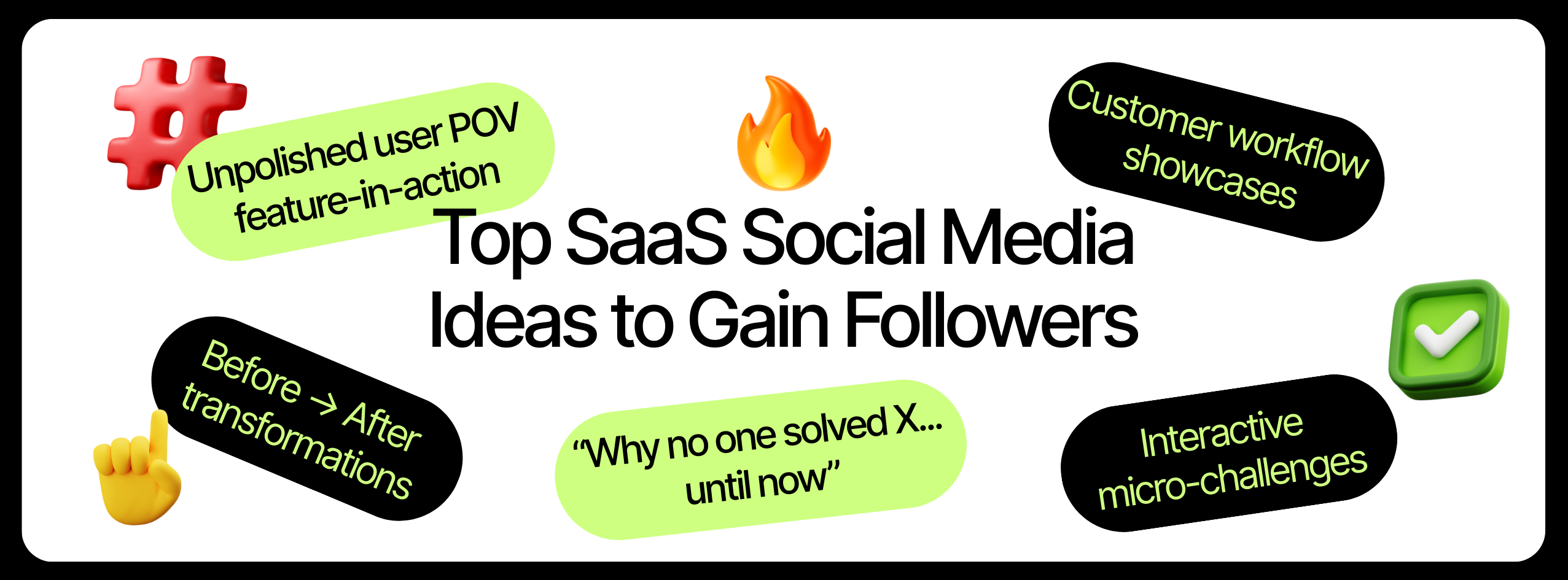Top SaaS Social Media Post Ideas to Gain Followers - 10k Analyzed

If you run marketing for a SaaS startup, you've probably faced the same problem every week:
"What should we post on LinkedIn / Twitter today to grow our following?"
Your options usually look like this:
- A product update nobody outside your team cares about.
- A generic blog snippet that dies quietly.
- Or yet another "We're live 🚀" post that gets a pity-like from your co-founder.
Meanwhile, the SaaS companies actually gaining followers are pulling thousands of impressions and customers from posts that look deceptively simple.
So what's the difference?
Instead of guessing, we went to the data.
We used Socialmon - our AI-powered inspiration vault - to analyze 10,000+ SaaS posts. We tagged, categorized, and dissected them to find the exact patterns that consistently win attention and turn into followers.
The result: 10 SaaS post formats you can copy right now to grow your account - complete with real-world examples, user reactions from Reddit, and ready-to-use post hooks (You can explore these same examples inside Socialmon.)
1. Customer Workflow Showcases ("Stack Stories")
Example viral SaaS post - from @fredyai.nocode
See more examples of customer workflow posts from SaaS teams on Socialmon↗
What It Is
A post showing how a real customer uses your SaaS inside their daily workflow. Instead of just saying "our tool saves time," you show the exact stack (your SaaS + other popular tools like Slack, Notion, HubSpot, or Figma) and how they fit together.
It's not about your product alone - it's about how your product helps someone do their job better.
Example Ideas
- "How a 3-person agency uses [Tool] + Slack + Notion to save 20 hrs/week."
- "Inside a freelancer's stack: how [Tool] + Google Sheets runs their entire client workflow."
- "This small team runs on just 3 tools: Slack, Figma, and [Tool]."
- "How one university used [Tool] + Notion to manage 200+ projects at once."
Why It Works
- Practical > promotional. Prospects see a real workflow they can imagine themselves using.
- Stack association. Mentioning bigger, well-known tools boosts trust ("if it fits with Slack, it'll fit with us").
- Social proof. Rooting the story in an actual customer makes it credible and relatable.
Tips
- Pick customers your target audience respects. A "3-person agency" workflow will resonate with other small agencies. A "fintech team" workflow will resonate with fintech.
- Highlight the stack, not just your tool. Show where you fit in and what you replace (e.g. "Notion + [Tool] instead of 4 spreadsheets").
- Keep it visual. Screenshots of boards, dashboards, or simple diagrams of the stack make it easy to follow.
- Show the benefit. Don't just list tools. Explain what outcome the stack enables (faster delivery, fewer mistakes, more clients handled).
2. Before → After Transformations
Example viral SaaS post - from Ruben Hassid
See more examples of 'Before → After' transformations from SaaS teams on Socialmon↗
What It Is
A simple post that shows the ugly "before" (manual, messy, painful) versus the clean "after" once your SaaS is used. Think split-screen, side-by-side screenshots, or quick GIFs. No need for explanation - the contrast tells the whole story.
Example Ideas
- "Before: 12 tabs open. After: one clean dashboard."
- "Here's what onboarding looked like before [Tool] vs. now."
- "Our customer used to do this in Excel. Now it's one click."
- "Before: 40min manual reports. After: 2min auto-generated PDFs."
- "How this team went from chaos to clarity in under a week."
Why It Works
- Contrast = clarity. The pain of the "before" makes the "after" look irresistible.
- Instant dopamine. People love transformations - it triggers the same satisfaction as makeover videos.
- Shareable. Easy for someone to send to a teammate: "We need this."
Tips
- Exaggerate the pain. Make the "before" feel as painful as it really is (cluttered spreadsheets, 20 browser tabs, confusing forms).
- Keep text minimal. Let visuals carry the story. One or two lines max.
- Make it obvious. The value should be clear at a glance, even if someone scrolls past quickly.
- Keep it visual. A screenshot pair, GIF, or raw clip is enough - don't overcomplicate it.
3. Unpolished User POV Feature-in-Action
Example viral SaaS post - from @quizard
See more examples of unpolished user POV product showcases on Socialmon↗
What It Is
A raw, screen-recorded clip showing your SaaS solving a real problem from the user's point of view. Start with the pain your audience feels every day, then show how your tool removes it in a few clicks.
Example Ideas
- "Why did nobody tell me this button existed?"
- "5 years of HR and I just found out about this..."
- "We wasted 100+ hours before we added this workflow."
- "10 years in finance and I only now learned this is one click."
- "Running an agency for 3 years and I was doing this manually the whole time🤦♂️."
- "This part of my job used to ruin my Fridays. Now it takes 20s."
- "I thought everyone else was suffering through this too."
- "This one feature replaced 12 spreadsheet tabs for me."
Why It Works
- Trust > polish. Raw clips feel authentic. Viewers believe what they see.
- Instant payoff. No need to imagine the value - it plays out in front of them.
- POV connection. Seeing a mouse move and buttons clicked creates the "that could be me" effect.
Tips
- Pick one painful task. Don't demo everything - focus on a workflow your audience instantly recognizes.
- Lead with pain. Show the messy "before" (cluttered sheet, repetitive task, empty state), then the clean "after."
- Keep it short. Under 30s. Anything longer feels like a tutorial, not a feed post.
- Ship it raw. Don't add background stock footage, or branding overlays. The lo-fi feel is the point.
- Get inspired. Collect raw POV examples from your industry inside Socialmon - we've curated 50+ of these.
4. Market Gap Callouts ("Why No One Solved X... Until Now")
Example viral SaaS post - from Eric Siu (founder of ClickFlow)
See more examples of Market Gap Callouts from SaaS teams on Socialmon↗
What It Is
A post that calls out a big, annoying gap in your industry - something everyone silently struggles with but no product has solved properly - and then shows how your SaaS fixes it.
Example Ideas
- "99% of payroll SaaS still can't auto-calc prorated leave. We fixed it."
- "Why does no CRM let you do [basic task]? We built it."
- "This blind spot wastes 5 hrs/week for every team. Not anymore."
- "Every founder I know complains about this. Here's how we solved it."
- "One gap in every project management tool. Here's ours in action."
Why It Works
- Taps into frustration. When you put words to a pain everyone feels, they lean in.
- Positions you as the innovator. You're not just another tool; you're solving what others ignored.
- High comment bait. People pile in to agree, debate, or share their own workarounds.
Tips
- Pick a gap that's obvious. It should be something your audience experiences weekly, not a niche edge case.
- Call it out directly. Don't soften it - name the pain and why it sucks.
- Pair with your fix. Show your product solving it in action, not just text.
- Back it up. Add a quick GIF, raw screen recording, or even a customer quote.
5. Customer-Generated Hacks (Unexpected Use Cases)
Example viral SaaS post - from @notionhq
See more examples of customer-generated hack posts from SaaS teams on Socialmon↗
What It Is
A post that spotlights how customers are using your SaaS in creative or unexpected ways. These aren’t use cases you advertised — they’re clever hacks your users discovered that expand what your product can do.
Example Ideas
- “We built [Tool] for CRMs. One uni used it to track thesis projects. Here’s how.”
- “This freelancer turned our project tool into a personal finance tracker.”
- “The hack our customers came up with that we now recommend to everyone.”
- “We never built [Tool] for this use case, but… it works ridiculously well.”
- “From side hustle to full ops stack: how one customer bent [Tool] to their will.”
Why It Works
- Social proof with a twist. Real customers showing off builds instant trust.
- Sparks imagination. Readers think, “oh wait, we could use it like that too.”
- High shareability. People love clever workarounds and unexpected solutions.
Tips
- Let customers be the star. Quote them directly or show their setup.
- Pick surprising hacks. The more unexpected, the more engaging.
- Show, don’t tell. Screenshots or quick clips of the hack are essential.
- Celebrate it. Frame it as “look how creative our users are” — not “look how versatile our product is.”
6. Interactive “Try This” Micro-Challenges
What It Is
A bite-sized challenge that invites people to try your product instantly. Think: “Build this in under 60 seconds,” or “Upload a file and watch what happens.” It turns a passive viewer into an active tester right from the feed.
Example Ideas
- “Can you build an invoice in 60s? Try it.”
- “Upload a doc. Watch what happens in 10s.”
- “Most people fail this until they try [Tool].”
- “Challenge: replace 12 tabs with one dashboard in under a minute.”
Why It Works
- Turns curiosity into action. People love testing themselves.
- Gamified hook. A simple challenge makes the post fun, not salesy.
- Lower barrier to trial. Instead of “sign up for a demo,” it’s “see what happens in 30s.”
Tips
- Pick a wow moment. The challenge should showcase your product’s most impressive transformation.
- Time-box it. Add urgency (“60s,” “2 clicks”) to make it feel achievable.
- Make it frictionless. No credit card, no 10-step signup — one click and they’re in.
- Show proof. Pair the challenge with a raw screen recording of you doing it yourself.
7. Myth-Busting in Your Category
Example viral SaaS post – from @color_me_bold
See more examples of mythbuster posts from SaaS teams on Socialmon↗
What It Is
A post that calls out a common belief in your niche that isn't actually true - and then proves it wrong with data, a demo, or a customer example. Format it as a bold "Myth vs. Truth" statement so it's easy to scan.
Why It Works
- Hooks attention. Contrarian takes stop the scroll.
- Educates with proof. You're not just shouting an opinion - you back it up.
- Positions you as an authority. If you can bust myths, you look like the expert who actually understands the space.
Example Ideas
- "Myth: CRM migration takes 6 months. Truth: 80% of users finish in 48 hours."
- "Myth: SaaS pricing has to be complex. Truth: simple wins."
- "Myth: churn is inevitable. Truth: here's how one team cut it 40%."
- "Myth: you need enterprise IT to set this up. Truth: we did it in under an hour."
- "Myth: reporting is always a pain. Truth: 2 clicks."
Tips
- Pick myths your audience already complains about. Migration pain, setup time, churn inevitability, "needs an enterprise team," etc.
- Keep it simple. One myth per post. Don't overstuff.
- Pair with evidence. A stat, a GIF demo, or a customer quote seals the point.
- Make it visual. Use bold "Myth" and "Truth" headings in a carousel or post graphic.
8. "What Good Looks Like" Benchmarks
What It Is
A post that shares concrete benchmarks for performance in your space - open rates, activation times, churn percentages, conversion rates. These numbers give your audience a reference point to measure themselves against.
Example Ideas
- "What a good onboarding flow looks like: 30-40% conversion rate."
- "A healthy churn rate for SaaS: 3-5% monthly. Here's how to beat it."
- "A high-performing onboarding email: 45% open rate, 11% CTR. Example below."
- "Most teams think their activation is slow. Here's the benchmark: under 5 minutes to first value."
- "Here's the real benchmark for SaaS pricing pages (and how yours stacks up)."
Why It Works
- Everyone craves benchmarks. Founders and marketers want to know if they're "doing okay."
- Saves and shares. People bookmark benchmark posts to revisit, and they spread quickly inside teams.
- Positions you as plugged-in. Sharing anonymized or aggregated data shows you see across the market.
Tips
- Pick one metric per post. Don't overwhelm - go deep on one.
- Make it visual. Simple chart, bar graph, or screenshot of a dashboard works best.
- Add context. Don't just drop a number - explain why it matters and how to improve it.
- Make it actionable. Add 1-2 tips for improving toward the benchmark.
Conclusion
When we started analyzing 10,000 SaaS posts, we expected to find random hacks - one-off wins that couldn't be repeated.
What we found was the opposite: clear, repeatable patterns that any team can adapt. The companies consistently growing their social accounts weren't posting more often or spending more money - they were reusing proven formats that turn attention into followers.
That's exactly why we're building Socialmon - to make it effortless for you to see what's working in your niche, organize it, and apply it to your own campaigns. No more blank content calendars, no more "what do we post this week?" meetings. Just a steady stream of post ideas already validated in the wild.
👉 Stop gambling on posts. Start building with proven formats through Socialmon↗
Get 50 viral posts for your niche (free)






















